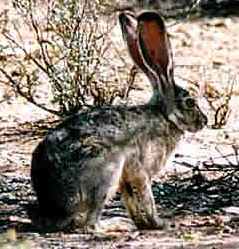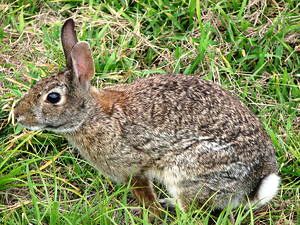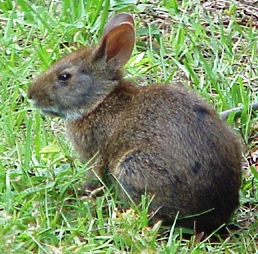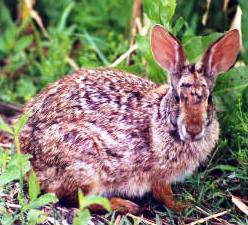Discover Florida Nature
It's time to explore the natural Florida


|
|
|
|
|
 Black-tailed
Jackrabbit- The Black-tailed Jackrabbit is a large, long-eared
rabbit of the open grasslands and desert scrub of the West. Its fur is a
dark buff color peppered with black, and its black-tipped ears are
almost the same length as its hind feet. Native of the western United
States, the black tailed Jackrabbit was accidentally introduced into
the Miami area in the 1930s and still persists around the Miami Airport,
Dade County, in the mowed grass habitat. The impact on native species is
unknown, but it is thought to have introduced Hoplopsyllus glacialis
affinis, a western North American flea associated with rabbits, into
populations of native cottontail and marsh rabbits in Florida.
Jackrabbits are strict vegetarians. During the spring and summer, they
feed on clover, alfalfa and other abundant greens. During the lean fall
and winter months, they subsist on woody and dried vegetation.
Jackrabbits always seem to be on their guard. They are very alert to
their surroundings and watchful of potential threats. They rely on their
speed to elude predators and, if they are lucky enough to escape, they
will flash the white underside of their tail to alert other jackrabbits
in the area. Black-tailed
Jackrabbit- The Black-tailed Jackrabbit is a large, long-eared
rabbit of the open grasslands and desert scrub of the West. Its fur is a
dark buff color peppered with black, and its black-tipped ears are
almost the same length as its hind feet. Native of the western United
States, the black tailed Jackrabbit was accidentally introduced into
the Miami area in the 1930s and still persists around the Miami Airport,
Dade County, in the mowed grass habitat. The impact on native species is
unknown, but it is thought to have introduced Hoplopsyllus glacialis
affinis, a western North American flea associated with rabbits, into
populations of native cottontail and marsh rabbits in Florida.
Jackrabbits are strict vegetarians. During the spring and summer, they
feed on clover, alfalfa and other abundant greens. During the lean fall
and winter months, they subsist on woody and dried vegetation.
Jackrabbits always seem to be on their guard. They are very alert to
their surroundings and watchful of potential threats. They rely on their
speed to elude predators and, if they are lucky enough to escape, they
will flash the white underside of their tail to alert other jackrabbits
in the area.  Eastern
Cottontail-
The cottontail is grayish-brown in color, has a distinctive white
"powder puff" tail, measures 14 to 17 inches in length and weighs two to
four pounds. The cottontail rabbit prefers a habitat of heavy brush,
strips of forest, weed and briar patches, abandoned fields and fringe
areas of cultivated fields. Periods of peak activity for cottontails
occur in early morning and at night. Rabbits are strictly
vegetarians with their main food being green plant parts during the
warmer months. When green vegetation is not available, rabbits will eat
young woody shoots and bark. Eastern cottontails are solitary animals,
and they tend to be intolerant of each other. Their home range is
usually between 5 and 8 acres, increasing during the breeding season.
Males generally have a larger home range than females. The eastern
cottontail has keen senses of sight, smell and hearing. It is
crepuscular and nocturnal, and is active all winter. During daylight
hours, the eastern cottontail remains crouched in a hollow under a log
or in a thicket. Here it naps and grooms itself. The cottontail
sometimes checks the surroundings by standing on its hind legs with its
forepaws tucked next to its chest. The cottontail is a quick runner and
can reach speeds up to 18 miles per hour. Eastern cottontails are
short-lived; most do not survive beyond their third year. Enemies
include hawks, owls,
foxes,
coyotes, weasels
and man. Eastern
Cottontail-
The cottontail is grayish-brown in color, has a distinctive white
"powder puff" tail, measures 14 to 17 inches in length and weighs two to
four pounds. The cottontail rabbit prefers a habitat of heavy brush,
strips of forest, weed and briar patches, abandoned fields and fringe
areas of cultivated fields. Periods of peak activity for cottontails
occur in early morning and at night. Rabbits are strictly
vegetarians with their main food being green plant parts during the
warmer months. When green vegetation is not available, rabbits will eat
young woody shoots and bark. Eastern cottontails are solitary animals,
and they tend to be intolerant of each other. Their home range is
usually between 5 and 8 acres, increasing during the breeding season.
Males generally have a larger home range than females. The eastern
cottontail has keen senses of sight, smell and hearing. It is
crepuscular and nocturnal, and is active all winter. During daylight
hours, the eastern cottontail remains crouched in a hollow under a log
or in a thicket. Here it naps and grooms itself. The cottontail
sometimes checks the surroundings by standing on its hind legs with its
forepaws tucked next to its chest. The cottontail is a quick runner and
can reach speeds up to 18 miles per hour. Eastern cottontails are
short-lived; most do not survive beyond their third year. Enemies
include hawks, owls,
foxes,
coyotes, weasels
and man. Marsh
Rabbit- The Marsh Rabbit, Sylvilagus palustris, is
found in freshwater and brackish marshes through out the state of
Florida. The marsh rabbit moves about much more during daylight than
the cottontail. It is reddish brown with a gray underside and tail, and
is 16-18" long. The marsh rabbit is slightly smaller, darker brown, and
has coarser hair than the cottontail. It has a small inconspicuous tail
that is dingy white on the underside and will often walk rather than
hopping as most rabbits do. The marsh rabbit is distinguished
from its cottontail cousin in another important way – it is a strong
swimmer and is usually found close to water. In Florida, this habitat
includes everything from fresh and brackish marshes to wet prairies and
flooded agricultural fields. The diet of the Florida marsh rabbit
consists of emergent aquatic plants and wetland plants including
grasses, sedge, maidencane, broad-leafed herbs, and weeds. Marsh rabbits
can breed year round but most often from December to June. Litters
contain 1-6 young. The nests are lined with grass and breast fur and
located on the ground in thickets, stumps or logs. By four weeks of age,
the young rabbits are weaned and are foraging for themselves. Marsh
rabbits are most active at night and at dawn and dusk. So, too, are many
of the marsh rabbit’s predators – owls, foxes,
bobcats
and alligators. Hurricanes and coastal
flooding also take a significant toll on rabbit populations,
particularly young rabbits and nestlings. Marsh
Rabbit- The Marsh Rabbit, Sylvilagus palustris, is
found in freshwater and brackish marshes through out the state of
Florida. The marsh rabbit moves about much more during daylight than
the cottontail. It is reddish brown with a gray underside and tail, and
is 16-18" long. The marsh rabbit is slightly smaller, darker brown, and
has coarser hair than the cottontail. It has a small inconspicuous tail
that is dingy white on the underside and will often walk rather than
hopping as most rabbits do. The marsh rabbit is distinguished
from its cottontail cousin in another important way – it is a strong
swimmer and is usually found close to water. In Florida, this habitat
includes everything from fresh and brackish marshes to wet prairies and
flooded agricultural fields. The diet of the Florida marsh rabbit
consists of emergent aquatic plants and wetland plants including
grasses, sedge, maidencane, broad-leafed herbs, and weeds. Marsh rabbits
can breed year round but most often from December to June. Litters
contain 1-6 young. The nests are lined with grass and breast fur and
located on the ground in thickets, stumps or logs. By four weeks of age,
the young rabbits are weaned and are foraging for themselves. Marsh
rabbits are most active at night and at dawn and dusk. So, too, are many
of the marsh rabbit’s predators – owls, foxes,
bobcats
and alligators. Hurricanes and coastal
flooding also take a significant toll on rabbit populations,
particularly young rabbits and nestlings. Swamp
Rabbit- A swamp rabbit is a wood rabbit of marshy coastal areas
from North Carolina to Florida. As the name suggest it lives mostly in
swamp or swamp like habitats. The swamp rabbit needs water within its
home range in order to survive. The swamp rabbit is not found outside of
the United States of America. The swamp rabbit is 18 to 22 inches long
with a 1 ½ inch long tail and weighs 3 ¼ to 5 ½ pounds. It is the
largest of the cottontail rabbit genus. It has relatively small ears.
Its fur is black to rust brown. It has cinnamon colored eye rings. Its
underside as well as its throat and tail are white. The male is slightly
bigger then the female. The swamp rabbit lives in groups. Its groups are
small and usually led by a dominant male. It is a good swimmer and will
swim without hesitation especially if it is threatened by a predator or
human. It is awake both during the day and the night. It shelters in an
above ground nest that is made out of plant stems and stalks. During the
breeding season the female will make a breeding nest that she lines with
her own fur. Swamp
Rabbit- A swamp rabbit is a wood rabbit of marshy coastal areas
from North Carolina to Florida. As the name suggest it lives mostly in
swamp or swamp like habitats. The swamp rabbit needs water within its
home range in order to survive. The swamp rabbit is not found outside of
the United States of America. The swamp rabbit is 18 to 22 inches long
with a 1 ½ inch long tail and weighs 3 ¼ to 5 ½ pounds. It is the
largest of the cottontail rabbit genus. It has relatively small ears.
Its fur is black to rust brown. It has cinnamon colored eye rings. Its
underside as well as its throat and tail are white. The male is slightly
bigger then the female. The swamp rabbit lives in groups. Its groups are
small and usually led by a dominant male. It is a good swimmer and will
swim without hesitation especially if it is threatened by a predator or
human. It is awake both during the day and the night. It shelters in an
above ground nest that is made out of plant stems and stalks. During the
breeding season the female will make a breeding nest that she lines with
her own fur. |
|
|
Advertise | Privacy Statement | Dog Encyclopedia | Video |Contact | Alaska Nature |
|